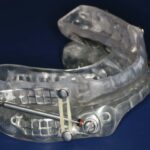What is Obstructive Sleep Apnea? During Sleep, gravity and muscle relaxation allows the tongue and surrounding soft tissue to fall back into the throat area obstructing airflow.
If left untreated, obstructive Sleep Apnea can contribute to an increased risk of hypertension (high blood pressure), diabetes, obesity, depression, dementia, Gastroesophageal Reflux Disease (GERD), heart attack and stroke.
What to look out for You may need an evaluation if you experience any of the following: Recurrent awakenings or insomnia, snoring, gasping or choking during sleep, waking up with a choking or gasping sensation, sleepiness or lack of energy during the day, sleepiness while driving, headache upon awakening/morning headaches, restless sleep, poor memory, forgetfulness, mood changes, and a decreased libido.
Therapy for Obstructive Sleep Apnea: If you have OSA (determined by taking a sleep test), you might benefit from using a machine that delivers air pressure through a mask while you sleep. With CPAP, the air pressure is somewhat greater than that of the surrounding air and is just enough to keep you upper airway passages open, preventing Apnea and snoring. Although CPAP is the most common method of treating Obstructive Sleep Apnea, some people find it cumbersome or uncomfortable. For some, a more comfortable and practical solution is wearing an oral appliance designed to keep your throat open. These devices are specially made to fit the individual for optimum effectiveness and comfort. A number of devices are available (and a few are pictured below), and you might need to try different devices before finding the one that works best for you.



It is important to follow up with your dentist repeatedly during the first year and then regularly after that to ensure that the fit is still good and to reassess your symptoms.




